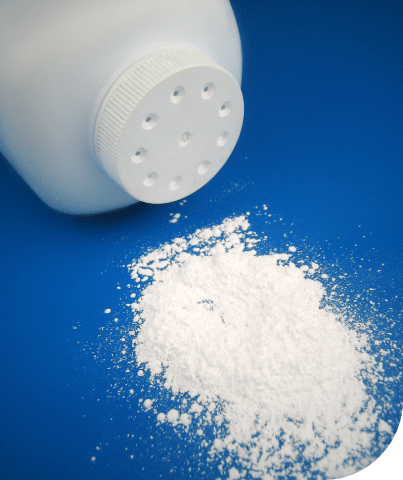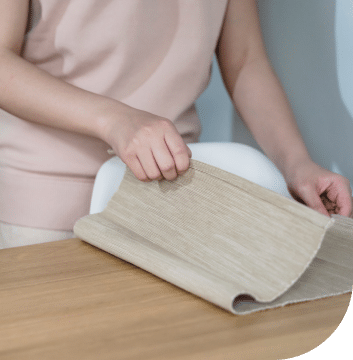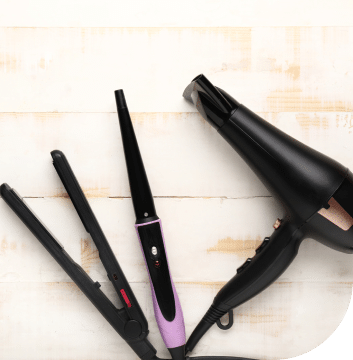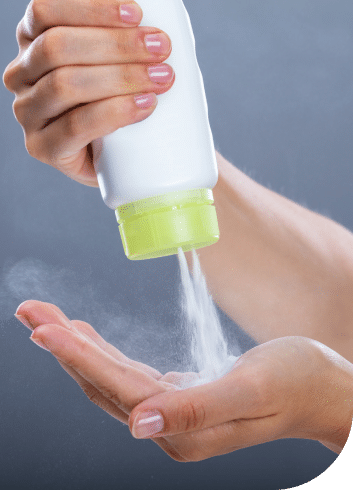Asbestos in Consumer Products
Asbestos is often associated with industrial settings and building products, but it was also used in products people purchased and used every day, including appliances, home decor, personal care products, and even toys. If you were diagnosed with mesothelioma and did not have occupational asbestos exposure, the exposure may have occurred in your home.
Home » National Mesothelioma Law Firm » Asbestos Exposure » Asbestos in Consumer Products and Materials » Asbestos in Consumer Products
Asbestos was known as a miracle mineral because it solved many building and manufacturing problems. Asbestos provided a means to fireproof, soundproof, insulate against heat and cold, insulate electricity, and prevent chemical reactions. It accomplished all of this while being lightweight, flexible, and strong. It was abundant, easily accessible, inexpensive, and indestructible.
Asbestos was incorporated into nearly every building component until the general population was surrounded by it. Throughout most of the 20th century, asbestos could be found in building insulation, electrical wiring, drywall, paint, flooring, ceiling tiles, roofing, and siding. It was even found in the adhesive that held it all together. This was true of residences, commercial buildings, and factories.
Construction and industrial companies were not the only businesses that found asbestos useful. Manufacturers of household goods and other consumer products also incorporated it into small everyday items. Some of those items are still in use.
The Value of Asbestos in Everyday Items
Asbestos was common in electrical and friction products because it insulated against heat and condensation. It prevented fires and electrical shorts and did not add significant weight to the items in which it was used. It was especially valuable in products that generated heat.
It was flexible enough to be woven into fabrics, paper, and products that needed to be molded, such as putties, adhesives, and clays. It added strength and durability to products. There were no downsides to using asbestos from a manufacturing perspective.
Unfortunately, the health effects of asbestos exposure are devastating. This negates all of the product benefits because there is no safe way to add asbestos to products. While the asbestos in many consumer products was encased, it was dangerous to those who manufactured the products and to anyone who opened, damaged, or repaired them.

Common Consumer Goods That Contain Asbestos
According to Asbestos 123, an asbestos testing company, more than 4,000 products contained asbestos. These products were generally manufactured between the 1930s and 1980. The products most likely to contain asbestos housed electrical wiring, generated heat, or were used near hot surfaces. If any part of the product was glued using adhesives, it may also have contained asbestos.
The safest course of action to protect your health is to assume that any product manufactured before 1980 contains asbestos until proven otherwise.
Asbestos Paper
Hundreds of thousands of rolls of commercial asbestos paper and asbestos tape were purchased annually by consumers and contractors until the Consumer Product Safety Commission banned their use for consumers in 1980.
These products were used in the following everyday consumer applications:
- Protection of walls near stoves and ovens
- Lining for kitchen shelves
- Protection of kitchen countertops
- Dining placemats
- Various uses in home maintenance and repairs

Independent testing found that workers involved in the manufacture of these products were exposed to 240 times the recommended average occupational exposure level over an eight-hour workday. This was recorded after the paper was manipulated for 10 minutes. Any tearing, wear, or other damage to this paper could also result in consumers experiencing significant asbestos exposure.
Appliances
Asbestos was extensively used in appliances, especially those that generated heat and had complex electrical circuitry. Heat generation increased the risk of fires, and the use of asbestos was meant to remediate these risks.
Hair Dryers and Curling Irons
Testing on more than 30 hair dryers manufactured by the following brands revealed that the majority of them emitted dangerous levels of asbestos during use:
- Clairol
- Conair
- Schick
- Hamilton Beach
- Norelco
- Sunbeam
- General Electric
- Gillette
- American Electric
- Sears, Roebuck & Co.
- Montgomery Ward
- JCPenney

The asbestos in hair dryers was found in the heat-insulation materials, according to Taylor & Francis Online. Asbestos also occurred in curling irons.
Large Appliances
While it may be tempting to purchase older used appliances in good condition, the following large appliances manufactured before 1980 contained asbestos:
- Microwaves – In the heating wire
- Refrigerators – In the inner packing of the compressor
- Air conditioners – In the inner packing of the compressor
- Washing machine – In the packing
- Clothes dryers – In the belts, electrical components, and combustion component insulation
- Stoves/ranges – In the heat-keeping materials
- Electric ovens – In the pipeline connection and heat-keeping materials
- Gas broilers – In the valve gasket and heat-keeping materials
These appliances may also have had asbestos insulation in the electrical wiring. In most of these appliances, the asbestos would have been encased inside where it likely would not have escaped and exposed the consumer.
However, the heat-keeping materials in stoves, electric ovens, and gas broilers may have included door gaskets, which could become worn or damaged over time and release asbestos fibers into the environment. Exposure was also possible in any instance in which the gasket needed to be changed.
Small Kitchen Appliances
Small kitchen appliances that generated heat contained asbestos, including the following:
- Crock-Pots – In the lining between the walls
- Coffee pots – In the heat insulation and electric wire insulation
- Rice cookers – In the power code protect materials
- Toasters – In the heat-keeping materials
- Blender – In the motor
- Kettles – In the electrical wires
According to Airsafe, an asbestos testing company, the asbestos in Crock-Pots was crocidolite asbestos, which is the most dangerous type.

Household Appliances and Accessories
Asbestos also found its way into small appliances used outside the kitchen, including the following:
- Irons – In the power cord insulation and under the hood, most notably on the Sad brand of irons
- Electric fans – In the motor
- Vacuum cleaners – In the insulation in the motor
Tools and Home Maintenance
Homeowners that performed their own home repairs or used power tools before 1980 may have encountered products containing asbestos, including the following:
- Electric tools – In the motor materials
- Insulation
- Textured paint
- Floor tiles and underlayment
- Door gaskets
- Soundproofing materials
- Joint compound
- Spackle
- Roof shingles and roofing felt
- Various adhesives, including tape
- Door and window caulking
Sports and Fitness
Asbestos has been found in sports and recreation equipment. A California jury awarded a family $4.4 million in damages following the death of a bowling alley owner who contracted mesothelioma after a lifetime of drilling holes in bowling balls.
Unbeknownst to the deceased, the bowling balls contained asbestos in the form of brake dust supplied by Honeywell, Inc. According to Brickley Environmental, it is common for old bowling balls to contain a combination of fiberglass and asbestos.
Other sports equipment that has historically contained asbestos includes the following:
- Bicycle seats – In the brake pads, frame parts, and tires
- Exercise bicycles – In the spin seat belts and inner electrical wiring
- Butterfly chest exercisers – In the back of the chair pads
- Exercise stepping machines – In the inner wiring and connection materials
- Treadmills – In the motor belts and inner wiring

Asbestos bicycle tires were not intentionally manufactured with asbestos. Asbestos was a common contaminant of talc. Talc was commonly used to produce rubber products in order to prevent these products from sticking in the machines.
Automotive
Asbestos was a popular product in the automotive industry, where it was commonly used in friction parts and electrical components. As a result, people who performed their own repairs on automotive equipment may have encountered asbestos in several components. Many of these components are still found on older cars today, and some imported aftermarket parts are still manufactured with asbestos.
The following automotive parts have contained asbestos in the past and may still contain it today:
- Brake pads and linings
- Transmission parts
- Motorcycle brake pads
- Motorcycle power connection equipment
- Paper in muffler repairs

Home Furnishings
Asbestos was commonly used in furniture from the 1930s through the 1960s. It was used to provide cushioning support in chairs, and couches with springs often had asbestos-containing undersides. It was also used in furniture stuffing and woven into fabrics. This furniture was frequently dyed silver or gold and had a fibrous appearance when closely viewed, according to the Asbestos Institute.
Asbestos could also be found in smaller home furnishings, such as in the inner electrical wiring of desk lamps.
Fireplace Materials
Asbestos was a popular substance in fireplace materials, including fire brick, mortar, adhesives, sealants, fireproof paint, fireplace accessories, and wood stove door gaskets. It was also used in chimney flues and linings. Asbestos was useful in these applications because it enhanced fire safety due to its imperviousness to fire.
Home
Asbestos had multiple decorative uses, especially around the holidays.
Asbestos During the Christmas Season
The Christmas season could be hazardous for fire during the 1900s because the bulbs used in Christmas lights were hot. Asbestos provided fire-resistant benefits to decor, reducing hazards in Christmas light bulbs and enhancing tablecloths, placemats, and tree skirts, according to the Moffitt Cancer Center.
Asbestos was used in artificial snow that could be purchased by the box to create a festive, snowy appearance. It was also added to wreaths to create an appearance of frost. This snow was sometimes made of pure chrysotile asbestos, according to Airsafe, an asbestos testing company.
Artificial asbestos snow was frequently used on Hollywood movie sets, including the iconic snow scene in The Wizard of Oz.

Other Asbestos-Containing Home Furnishings
Asbestos-containing bookbindings were popular during the mid-1900s, according to the Asbestos Institute. “Fahrenheit 451” was famously bound with asbestos to promote an image of a book that would never burn.
Artificial fireplace ash made of asbestos created a decorative glow that resembled real embers without burning up. They were used in gas and artificial fireplaces. The decorative asbestos material could be sprinkled throughout the fireplace, placed under artificial logs, or glued into place. The glue also contained asbestos.
People who used these products were exposed while sprinkling the ash and gluing it. The Consumer Products Safety Commission banned these products in 1977.
Wicks used in candles, lanterns, and some stoves were made of asbestos, allowing them to continue burning without destroying the wick. Burning asbestos in this manner could spread the fibers without degrading the asbestos. It takes extreme temperatures to destroy asbestos.
A study by the Journal of Thermal Analysis and Calorimetry found that a temperature of 1,000° Celsius, or 1,832 degrees Fahrenheit, was required to destroy the dangerous aspects of asbestos fibers. This cannot be achieved by burning wicks.
Toys
Asbestos generally was not intentionally used in toys. Instead, toys became contaminated with asbestos as a result of talc content. Toys that have been found to contain asbestos are typically imported from China, and many of these cases have been recent.

Crayons
In 2000, the Dixon Ticonderoga and Binney & Smith brands of crayons were found to be tainted with trace amounts of asbestos, according to the Consumer Products Safety Commission. Although the low level of asbestos exposure was determined to be low-risk, there is no safe level of asbestos.
As recently as 2015, testing by the Environmental Working Group found asbestos contamination in multiple samples of crayons from Dollar Tree, Party City, Amazon.com, and ToysRUs.com. The following four brands tested positive for amphibole asbestos, all of which were imported from China:
- Amscan Crayons – Positive for tremolite and anthophyllite asbestos
- Disney Mickey Mouse Clubhouse – Positive for chrysotile and tremolite asbestos
- Nickelodeon Teenage Mutant Ninja Turtle – Positive for tremolite asbestos
- Saban’s PowerRangers Super Megaforce – Positive for tremolite asbestos
Crime Lab Kits
In 2007, the Environmental Working Group also found asbestos in the following crime science kits, all of which were imported from China:
- EduScience Deluxe Forensics Lab Kit from Toys “R” Us – The black fingerprint powder tested positive for tremolite, chrysotile, actinolite, and anthophyllite asbestos.
- Inside Intelligence Secret Spy Kit from Buy-Rite – The white fingerprint powder tested positive for tremolite asbestos.
Children’s Clay
The Milton Bradley brand of clay known as Fibro-Clay manufactured from 1967 through 1975 was contaminated with asbestos according to testing. The product was used to make paper mache. It was recalled by the Consumer Product Safety Commission and Milton Bradley in 1983.
Model Airplane Heat Guns
Approximately 20,000 Top Flite heat guns used by model airplane hobbyists contained asbestos in the heat shields, and asbestos fibers were released with each use. This product was recalled by the Consumer Product Safety Commission in 1980.
Electronics
Asbestos was commonly added to wire insulation and electric motors to protect against overheating and prevent fires. While the asbestos in these products was generally encased inside, users could be exposed if the products were opened, such as during repairs.
Older televisions had asbestos in the fans and in the electrical insulation in the circuit boards.
According to WSHU Public Radio, at least one well-known antique radio brand, Catalin, included asbestos in the heat shields. It is likely that other brands did as well.

Heating Pads and Electric Blankets
Heating pads and electric blankets manufactured before 1980 were also likely to contain asbestos. Asbestos would most likely occur in the following components:
- Heat materials
- Heat lines
- Insulation

Fabrics
Asbestos was commonly added to fabrics that were used near fire and heat sources, including the following:
- Ironing board covers
- Potholders
- Oven mitts
- Fireproof gloves used to start fires
Asbestos was also used in flame-retardant clothing. This type of clothing was most often used by workers in occupations where the risk of being burned by fire was high, such as firefighters and certain aviators, according to Airsafe.
Asbestos Curtains
Asbestos curtains first became popular in movie theaters, where the large stage curtain was at risk of catching fire due to the close proximity of the large, hot stage lights. Asbestos was heavily used in the well-known large red velvety curtains commonly seen in older movie theaters and in some cases still used today.
According to Asbestos 123, if a fire broke out on stage, the curtain would descend and form a barrier between the audience and the fire, preventing casualties.
Asbestos curtains were also luxury home items that were marketed for their fire-resistance and sound insulation benefits, according to Bob Vila.
Cosmetics
Cosmetics are not regulated by the FDA. The FDA has the authority to distribute public bulletins but cannot mandate recalls or require testing, according to the Environmental Working Group. While asbestos is not deliberately added to these products, talc often is, even though it is widely known in the industry that talc may be contaminated with asbestos.
As a result, any product containing talc may also contain asbestos, including the following products:
- Talcum powder
- Baby powder
- Eye shadow
- Powdered foundations
- Compact powders
- Blush

Johnson & Johnson’s baby powder has been linked to ovarian cancer and mesothelioma. The Lanier Law Firm was the first law firm to prevail in a case linking asbestos in baby powder and ovarian cancer. In the case, our mesothelioma lawyers won a record verdict of $4.69 billion against Johnson & Johnson on behalf of 21 women.
This verdict was appealed all the way to the U.S. Supreme Court, where it was upheld, with a final recovery of $2.1 billion.
The FDA recently proposed a new rule to standardize testing for asbestos in talc-containing cosmetic products; however, The Lanier Law Firm attorney Darron. E. Berquist argues, “The proposed rule has some serious deficiencies if the goal is to prevent asbestos exposure through cosmetics. In this current form, the ruling would allow talc and cosmetic industries to continue poisoning people with contaminated talc”.
Children’s Makeup
The presence of asbestos in cosmetics has impacted children’s makeup, as was recently seen in cases involving two popular lines of children’s products: Justice and Claire’s.
In 2018, Justice recalled eight products from the “Just Shine” line of products that had tested positive for tremolite asbestos, according to ABC 7 News in Chicago.
According to the Clean Label Project, in late 2017, 17 makeup samples from Claire’s locations in nine states tested positive for asbestos. The popular children’s retailer disputed the findings, claiming that its own test results were negative for asbestos. Despite these claims, follow-up testing revealed that three of the four products tested contained high concentrations of asbestos.
Claire’s has since filed for bankruptcy, although it is unclear whether the asbestos findings are related.
Garden and Outdoor Products
Asbestos exposure in consumer goods is not limited to indoor household exposure.
Lawn and Garden Equipment
According to the EPA, asbestos may be found in the following components of small engines, such as lawnmowers, blowers, chainsaws, and other agricultural equipment:
- Asbestos gaskets
- Millboard
- Brakes and other friction components
- Electrical wiring

Potting Soil
Vermiculite has long been a popular soil additive because it improves drainage. Unfortunately, until about 1990, most of the world’s vermiculite came from the Libby mine in Montana, which was heavily contaminated with asbestos.
Cigarettes
The Kent Micronite brand of cigarettes used approximately 10 milligrams of crocidolite asbestos in each of its filters. According to a study published in Cancer Research, testing revealed that significant quantities of asbestos were inhaled during the first two puffs.
As a result, smokers with a habit of smoking a pack daily would have inhaled more than 131 million crocidolite fibers per year. Fortunately, these cigarettes were not manufactured past the 1950s.
How dangerous is asbestos in consumer goods?
The danger of asbestos exposure varies depending on the type of product and how it is used. Products with asbestos in electrical wiring and circuitry may not release asbestos unless the asbestos-containing areas are opened and accessed. Most regular users of these products would not have done this.
However, asbestos was readily released into the environment from several consumer products, in some cases right out of the box. Other products released asbestos fibers as they began to wear with use.
Exposure to asbestos can lead to deadly illnesses, including asbestosis, mesothelioma, and lung cancer. These conditions typically do not develop until at least a decade after the first exposure and often several decades afterward. One of the dangers of asbestos exposure is that symptoms typically fail to appear until after a deadly disease has developed.
Who is liable for asbestos exposure from consumer goods?
Liability for asbestos exposure falls upon the manufacturers and suppliers of the products that contained asbestos. These companies can be held liable on the basis that they mined, manufactured, processed, imported, distributed, or sold products that were harmful because of a poor product design or manufacturing defect.
They can also be held liable because they failed to provide adequate warnings or safety instructions. Most companies that manufactured and marketed asbestos-containing products knew asbestos was harmful but actively concealed this information, choosing to sacrifice public safety for profits.
What are my legal options?
If you developed mesothelioma or another asbestos-related illness after using tainted consumer goods, you may have grounds to file a mesothelioma lawsuit against the companies that manufactured and sold the products. You may also be able to name the manufacturer that provided the raw asbestos materials.
The Lanier Law Firm has more than 30 years of experience handling mesothelioma claims, and we have seen firsthand the devastation a mesothelioma diagnosis brings. We are familiar with the products that expose people to asbestos, and we have the skills and resources needed to hold large asbestos companies accountable.
We are passionate about getting justice for our clients, and it shows in the notable verdicts and settlements we consistently achieve on their behalf. Contact us today to schedule a free consultation.
By submitting this form, you agree to our terms & conditions. Please read the full disclaimer



